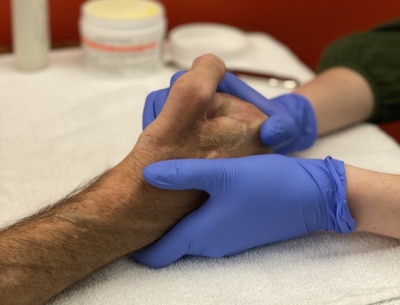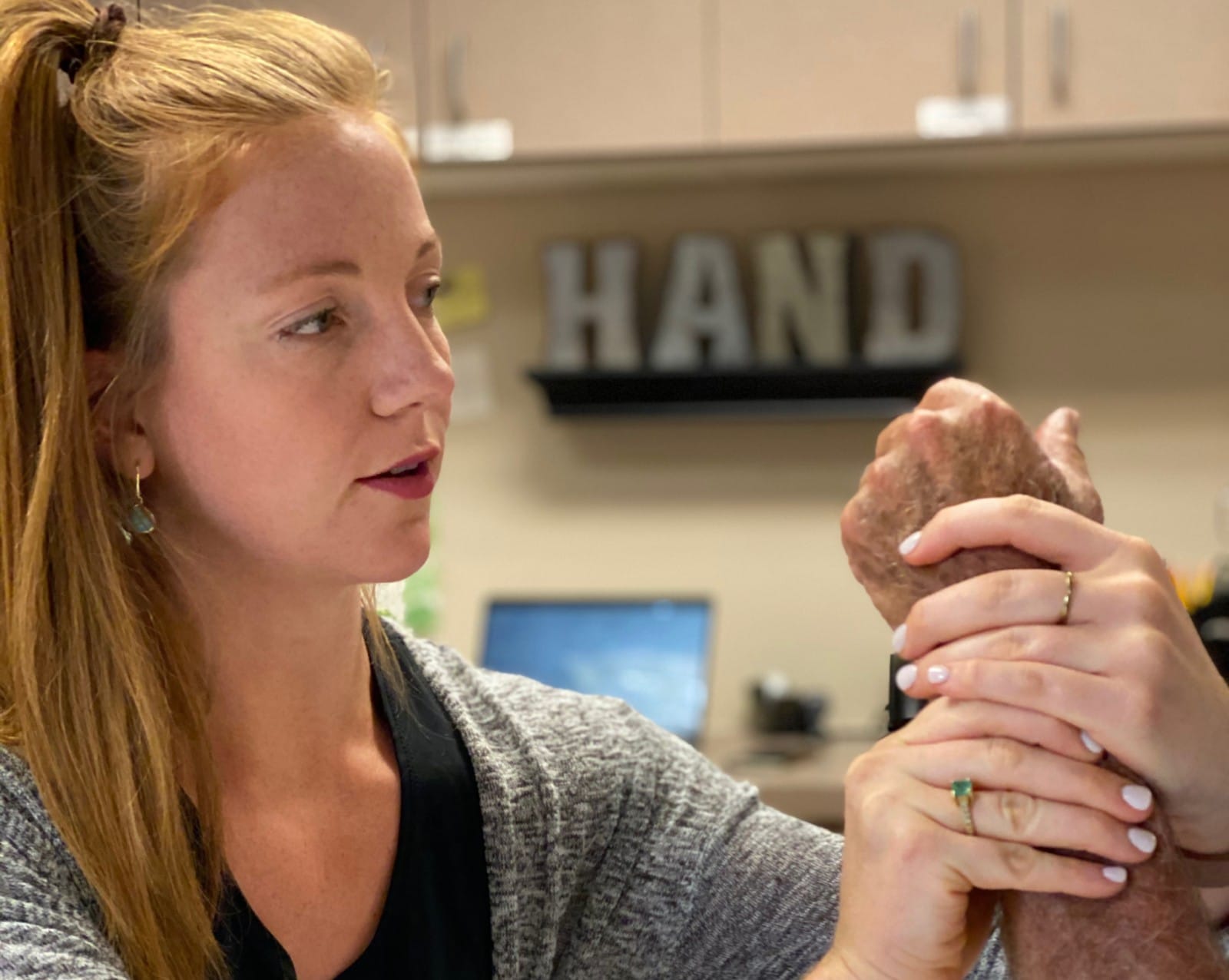You’ve heard of (and maybe even experienced) common conditions like carpal tunnel syndrome, tennis elbow, wrist tendonitis, and trigger finger. But did you know there’s a specialist who is specifically trained to treat these and other ailments of the hand, wrist and arm? You don’t have to resort to surgery or even a supply of ibuprofen to try to manage the pain of arthritis, carpal tunnel, or other painful problems in your hands, wrists and arms. At Spooner Physical Therapy, we have 12 hand therapists across the valley who specialize in providing treatment for issues such as these, including any other problems with the hand, wrist and arm. We talked with Ty J. Pehrson, MOTR/L, CHT, to learn more about how hand therapy can help you get a handle (pun also intended) on your pain and get you moving and working comfortably again.

Ty Pehrson, MOTR/L, CHT, Director of Hand Therapy
What is Hand Therapy & What Do We Treat?
First of all, don’t let the name mislead you: Hand therapy is about treating more than the hand itself. “We treat the shoulder down to the fingertips, so the whole upper extremity,” Ty says. “Someone could be having carpal tunnel syndrome, and it’s originating from their shoulder or their neck. We treat that whole kinetic chain.” Hand therapists are highly specialized occupational therapists or physical therapists who become certified through years of additional training, study, and successful completion of an arduous exam – all to make you feel and move better.
You May Need Hand Therapy If…
There’s a huge range of upper extremity disorders and injuries that hand therapists treat, whether caused by overuse or a traumatic incident. Crushed your finger in a car door (ouch!)? Hand therapy can help. Have pain in your wrist from the repetitive motion of typing? Your hand therapist is here for that. Are you a diabetic with numbness in your hands? Hand therapy can help you restore circulation. Is arthritis in your elbow or wrist limiting your ability to lift groceries or swing your tennis racket? Try hand therapy first. “What therapy does is address the issue causing the pain in the first place,” Ty says. The goal is to relieve the pain long-term, rather than simply mask the symptoms, which is what nonsteroidal anti-inflammatory drugs (NSAIDs) do instead.
Read more about “Wrist Pain and Physical Therapy: What You Need To Know” on the Spooner Blog.
Treating Pain Caused by Pressed Nerves
Ty explains that there are five large spinal nerves that exit from the spinal cord at the neck to form a bundle of nerves called the brachial plexus. At the brachial plexus, these nerves branch off to run down your arm all the way to your fingertips. Three of these nerves – the radial, ulnar, and median nerves – are responsible for providing movement and feeling to your arm. That’s why when you have painful or uncomfortable symptoms in your arm, elbow, wrist, or hand, it’s often a result of something (often inflammation) putting pressure on these nerves. Carpal tunnel syndrome is a classic example of this. So is peripheral neuropathy (loss of feeling in the hands and poor circulation), a condition commonly associated with diabetes. Seek treatment from a hand therapist if you experience one or more of these symptoms:
- numbness and tingling in the hands or fingers
- aching or pain in the wrist
- weakness of the hands and grip
- an electrical shock feeling
- increased pain at night that wakes you in your sleep
Read more about “Carpal Tunnel & Cubital Tunnel” from the Spooner blog and how hand therapy can help!
Treating Pain Caused by Inflammation and Swelling
Hand therapists also treat inflammation and swelling of the tendons in the upper extremity known as tendonitis, as well as the swelling, pain, stiffness and decreased range of motion caused by arthritis. A few examples of these conditions include tennis elbow (lateral epicondylitis), trigger finger (stenosing tenosynovitis), and De Quervain’s tenosynovitis (affecting the tendons in your wrist).
Treating Traumatic Injuries
If you experience trauma to your hand, wrist, or arm, hand therapy is instrumental in returning that body part to full health. “The most common injury we see is wrist fractures, as well as ligament damage in the wrist due to a fall. Many times it’s obvious that there is an issue because the wrist is deformed, so they’ll probably go to the hospital, where it will be put in a splint or a cast for four to six weeks. Then hand therapy comes in and helps them get full motion back in the wrist,” Ty says.
What Can I Expect If I Try Hand Therapy?
At Spooner Physical Therapy, you’ll start with a complimentary assessment or initial evaluation. Ty says your first appointment will look something like this:
- Your therapist will take a thorough medical history, including finding out if you’ve ever had surgery to the area that’s giving you trouble.
- He or she will ask you about symptoms, want you to describe them, and ask how long you’ve been experiencing them.
- Your therapist will check all the nerves to see if any are being pressed, and will also look at your posture.
- Your therapist will take you through several movements to assess strength and function.
- You’ll discuss your goals and set expectations for treatment.
Your hand therapist will set up a treatment plan for you that will include at-home exercises and treatments (such as ice to reduce inflammation or “contrast” baths to increase circulation), in-clinic exercise & manual therapies (such as soft-tissue mobilization, passive stretching, or even a paraffin dip), and in some cases, a splint to put your affected area in a neutral position, allowing it to heal. “Our goal as hand therapists is to resolve the issue that’s causing the disorder long term, so they can continue to do their job or activity without causing further damage,” Ty says.
Learn more about Hand Therapy at Spooner or Schedule an appointment or complimentary movement screen with a Spooner occupational therapist at one of our locations throughout the valley.

